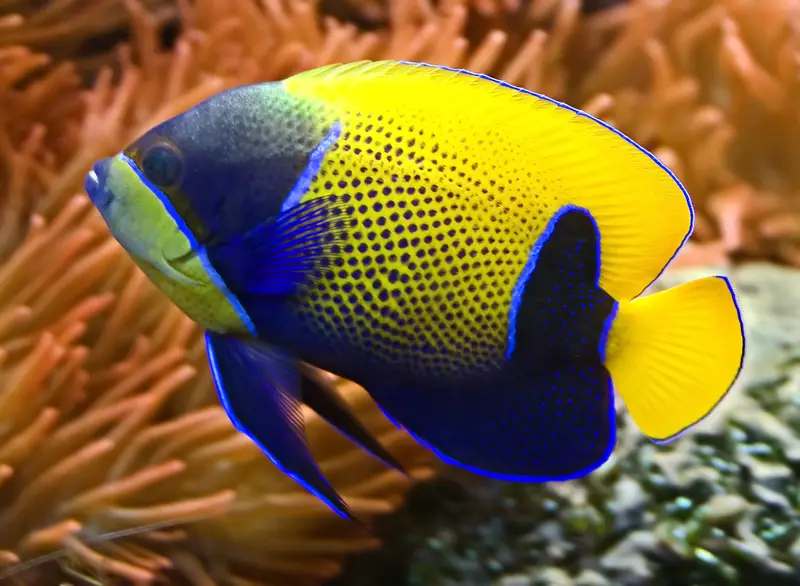Fish come in an almost endless combination of colors. However, are there any fish species that are “only” covered in blue and yellow? Well, yes, there are quite a few to know about and this is our Top 10.
1. Blue and Yellow Fusilier
The blue and yellow fusilier (Caesio teres) belongs to the Caesionidae family. You can find them in the Indian Ocean but also within the waters of the western & central Pacific Ocean. You might observe them when snorkeling in the Red Sea, eastern Africa, Indonesia or Hawaii.
These fish prefer to swim and feed in shallow water, even though they can be found in deeper areas as well. For us snorkelers it’s good to know that they usually stay close to coral reefs, somewhere between 3 – 5 feet in depth. However, they are common in deeper areas as well, up to 200 feet in depth.
Blue and yellow fusilier fish prefer to swim in schools. You can recognize them by their shiny blue body and a yellow tail that partially covers their upper back. They grow up to 12 inches (30 centimeters) in length. Their favorite meals include tiny fish, algae and plankton.
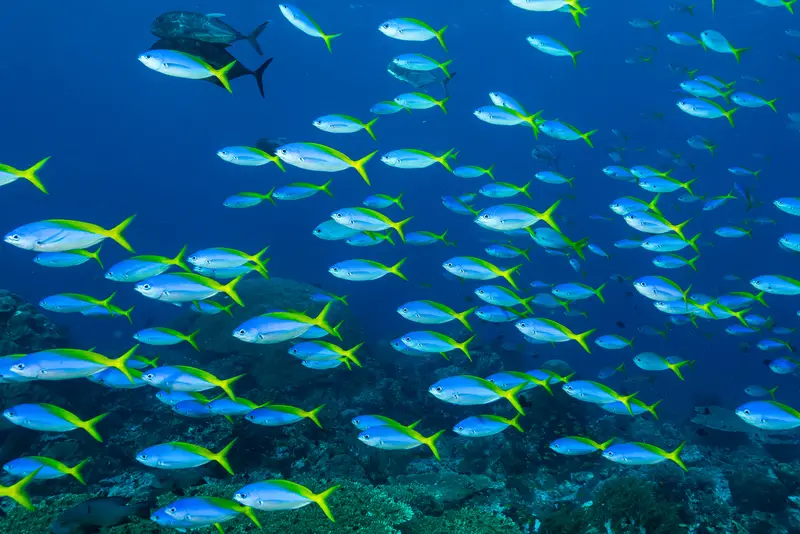
2. Blue and Yellow Parrotfish
Blue and yellow parrotfish (Scarus coeruleus) belong to the Scaridae family. You can spot them in the western Atlantic Ocean, like for example Florida or the Bahamas. Their territory also includes the Caribbean Sea and the Gulf of Mexico (which are part of the western Atlantic Ocean).
These fish prefer to stay close to shallow coral reefs where they feed on algae. So yes, it’s definitely possible to spot them when snorkeling. On the other hand, depending on the location, they can also be found in deeper areas. Ever heard those crunching noises below the ocean surface? Chances are a nearby parrotfish was chewing on some algae-covered coral.
You usually find these fish in small groups, or maybe even on their own. Blue and yellow parrotfish grow up to 16 inches (40 centimeters) in length. If you’re lucky you might spot larger versions, up to 24 inches (60 centimeters) in length.
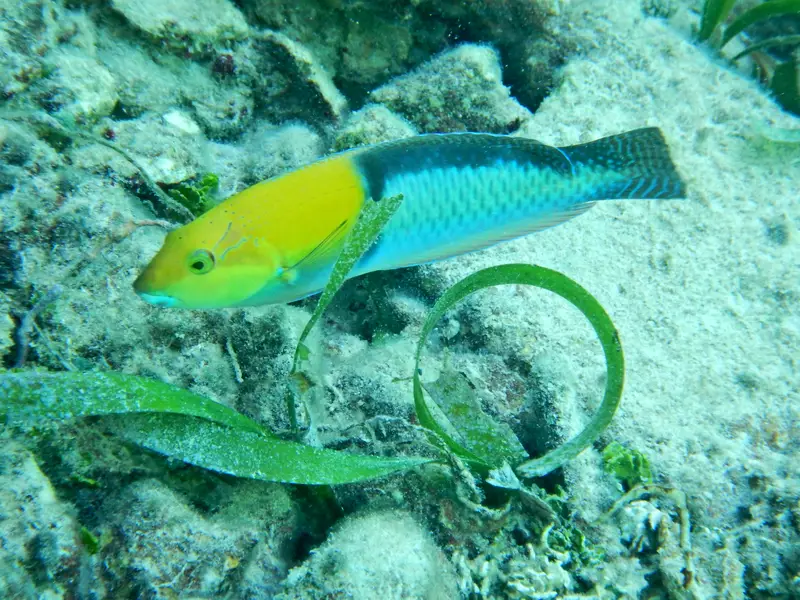
3. Blue and Yellow Tang
Blue and yellow tang (Zebrasoma flavescens) belong to the Acanthuridae family. You can spot them in the Indo-Pacific waters, especially East Africa and Hawaii.
These fish stay close to coral and rock formations. They prefer warm water, especially when currents are present. Snorkelers are able to observe them in shallow water up to 4 feet in depth, but scuba divers can also see them in deeper areas. These fish are pretty active and able to swim quite a distance. That’s how they collect a good amount of food.
Blue and yellow tang often swim in small groups. They grow up to about 10 inches (25 centimeter) in length, even though some can be bigger. It’s easy to identify these fish with their blue body and appealing yellow tail. Their favorite food includes algae and small invertebrates.
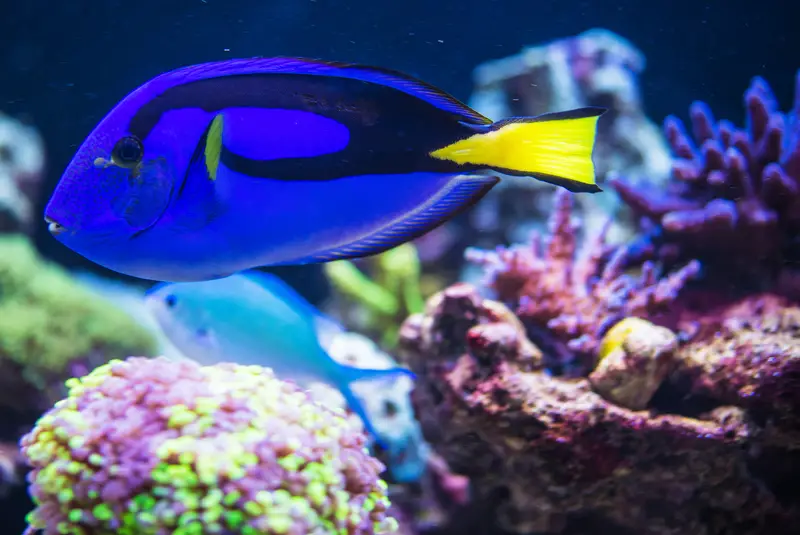
4. Blue and Yellow Triggerfish
The blue and yellow triggerfish (Xanthichthys auromarginatus) are also known as “Blue Jaw Triggerfish” and belong to the Balistidae family. Snorkelers are able to observe them in the Indo-Pacific waters, especially the Red Sea, Indonesia and the Maldives.
It’s not uncommon to spot a few in shallow coral reefs, even though they don’t mind to dive down a little. Keep your distance so they don’t become aggressive. They usually swim alone or in pairs and grow up to about 10 -12 inches (25 – 30 centimeters).
We mentioned their blue jaw already, but as the picture below shows this fish is pretty much covered in (light) blue. Bright yellow stripes around its dorsal fins and tail make this an easy-to-spot fish. Blue and yellow triggerfish prefer to eat algae and small invertebrates.

5. Blue and Yellow Snapper (Bluestripe Snapper)
Also known as bluestripe snapper, and officially called Lutjanus kasmira, these fish belong to the Lutjanidae family. They are common within the Indo-Pacific region (especially Australia, Indonesia and the Maldives).
Bluestripe snappers stay close to shallow coral reefs and any kind of rock formations. However, they can be found in deeper areas as well. It’s easy to identify them since they often swim in very large schools.
These fish can grow up to 14 inches (35 centimeters) in length, even though their average length is somewhere around 10 inches (25 centimeters). Their yellow body and tail is accompanied by 4 blue horizontal lines as the picture below illustrates. Bluestripe snappers prefer to eat tiny fish and invertebrates.
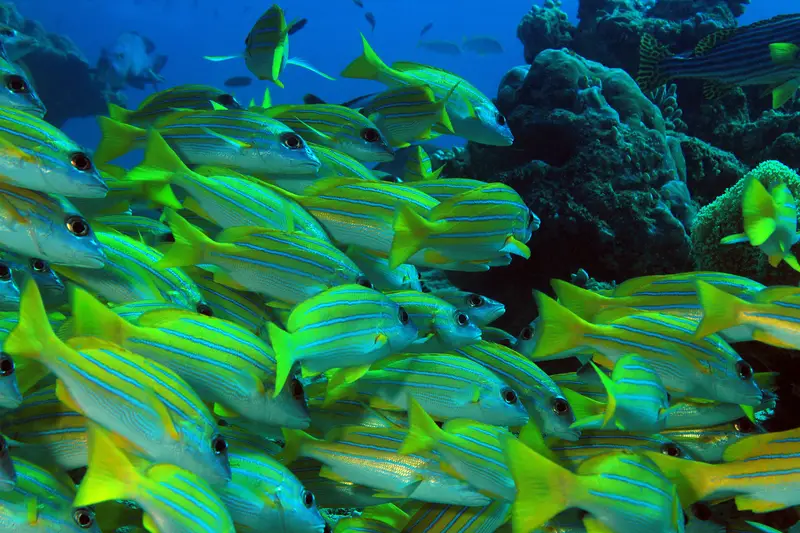
6. Blue and Yellow Angelfish
When it comes to angelfish, please note that there are quite a few blue and yellow species. Whenever people talk about blue and yellow angelfish, they usually refer to the Pomacanthus navarchus (see picture below). These fish belong to the Pomacanthidae family.
Snorkelers can spot these fish in the Indo-Pacific waters, like for example the Red Sea or Africa’s east coast. It can be tricky to observe them because they have a taste for very healthy coral reefs with little tourism (yes, they are quite picky about their habitat). If however you’re in the right area, they usually stay close to both shallow and deeper coral reefs.
Blue and yellow angelfish prefer to swim alone. They grow up to about 16 inches (40 centimeters) in length and feed on algae, small invertebrates and sponges.
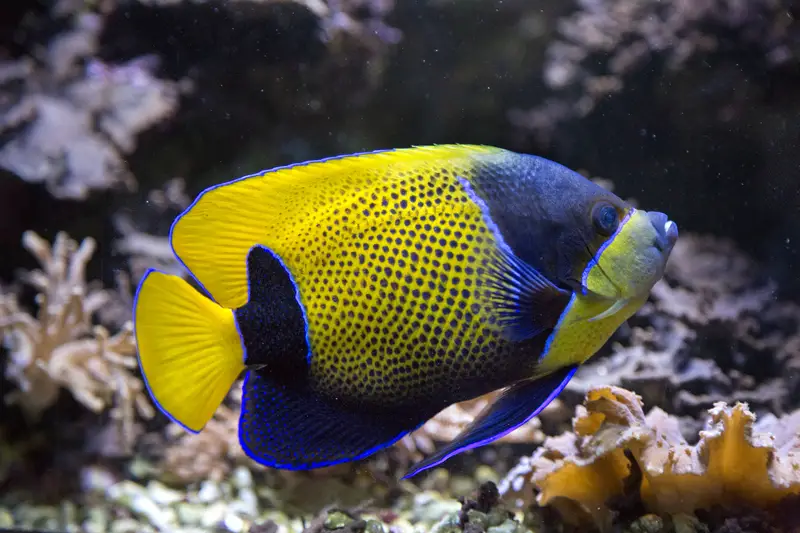
7. Lemonpeel Angelfish
Lemonpeel angelfish (Centropyge flavissimus) also belong to the Pomacanthidae family. They live in the Pacific and Indian Oceans. If you’re a snorkeler, expect to spot a few in Hawaii, the Maldives and the Australian Great Barrier Reef.
These fish enjoy both shallow and deeper reefs. Compared to some other blue and yellow fish species, Lemonpeel angelfish can be a little hard to observe. They often hide in rocky areas, but who knows you’ll be able to spot a few if you pay close attention.
Lemonpeel angelfish grow up to about 4 inches (10 centimeters) in length. As the picture below shows, yellow is their dominating color. However, notice the thin blue lines?
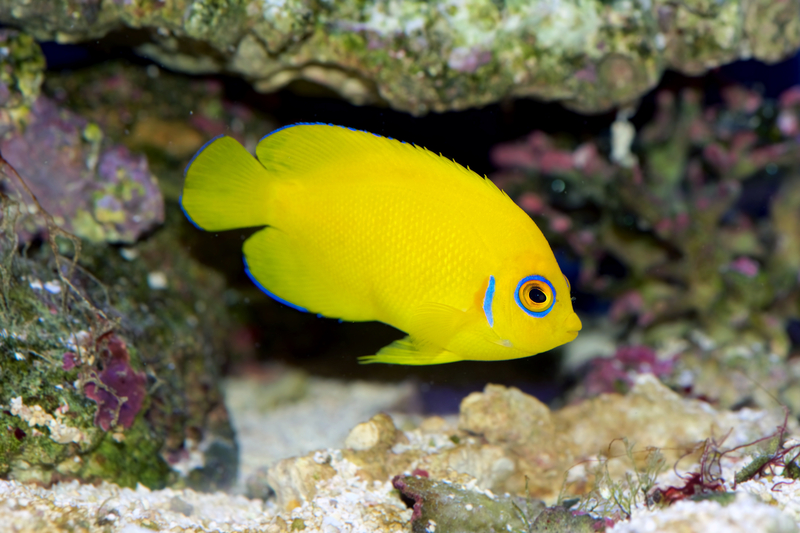
8. Blue and Yellow Peacock Cichlid
The blue and yellow peacock cichlid (Aulonocara baenschi) belongs to the Cichlidae family. Its main habitat is Lake Malawi in east Africa. We never snorkeled there, but if you do, who knows you’ll be able to spot a few.
Blue and yellow peacock cichlids are freshwater fish and often swim near underwater rock formations. They grow up to 6 inches (15 centimeters) and live in groups. Observe them from a distance because they tend to be a little territorial.
Their blue and yellow color combinations can differ. In other words, some could show more bluish areas than others. Their favorite dinner includes algae and small invertebrates like worms and insects.
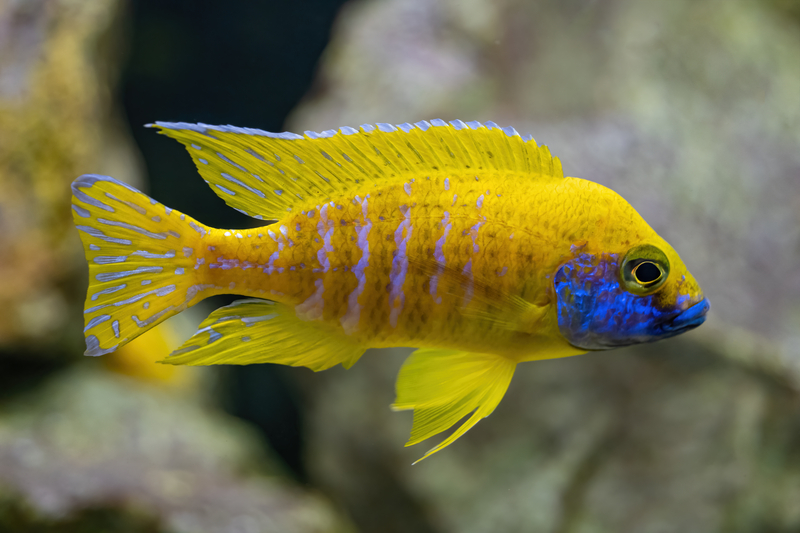
9. Blue and Yellow Fairy Basslet
The blue and yellow fairy basslet (Gramma dejongi) belongs to the Grammatidae family. Snorkelers are able to spot these fish in the Caribbean Sea. Your biggest chances to observe a few are on the island of Curacao, even though they seem to also enjoy the waters of Bonaire.
These fish stay close to coral reefs in shallow water. You need to be a little patient in order to observe them because they’re pretty shy and therefore often try to hide. They grow up to 3 inches (7-8 centimeters) in length.
As you can see from the picture below, these fish have a blue head and a yellow tail. Their favorite meals include small crustaceans and invertebrates.
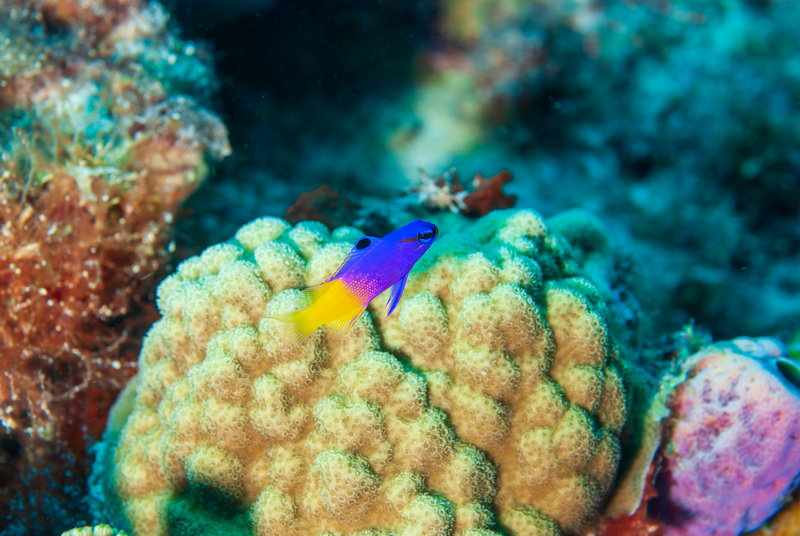
10. Blue and Yellow Damselfish
Blue and yellow damselfish (Chrysiptera cyanea) are part of the Pomacentridae family. There are more than 300 versions of damselfish, but one of them comes with blue and yellow colors. Snorkelers can spot them in the Indo-Pacific waters, especially the Red Sea and Hawaii.
These fish enjoy to swim around shallow coral reefs. They’re known to be aggressive and very territorial. They prefer to swim in groups. You can spot them in depths of around 3 feet (1 meter), even though they’re quite common in deeper areas as well.
Blue and yellow damselfish are pretty small with an average length of about 3 inches (7-8 centimeters). Their blue body with yellow fins and a yellow tail makes it easy to identify them. When it’s time for dinner they look for algae and small invertebrates.
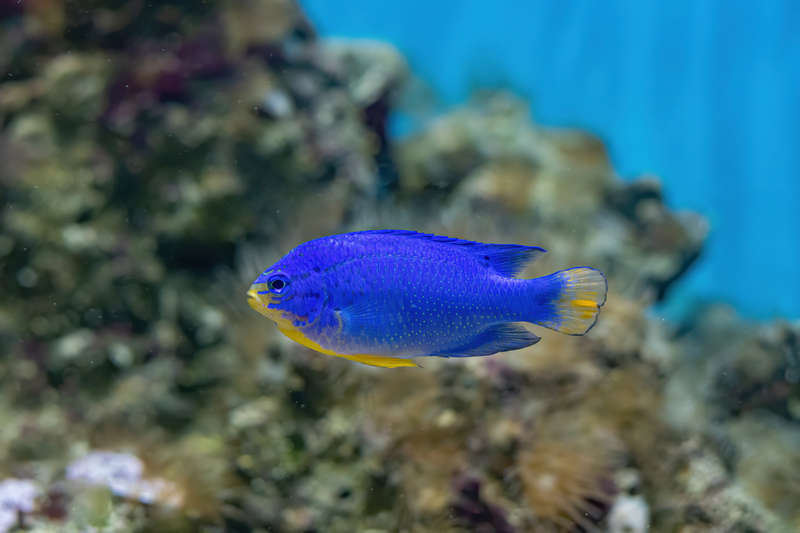
Final Thoughts
Most fish with a combination of blue and yellow colors can be found around shallow coral reefs. Not every snorkel location allows you to spot the above species, however, depending on your location there might just be a few to observe.
Related Articles
If you’re interested in finding and identifying fish with specific color combinations, maybe you’ll also like our list of 10 black and white fish. Another article we enjoyed to write covers various interesting types of yellowtail fish.

